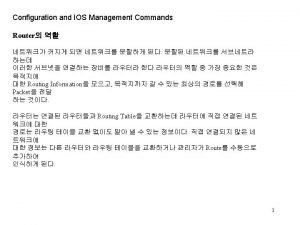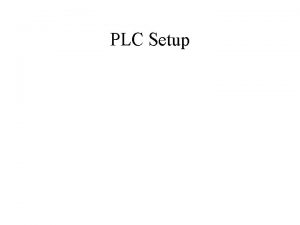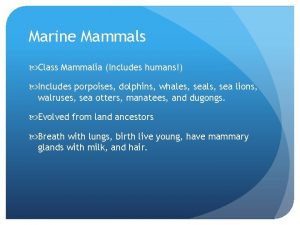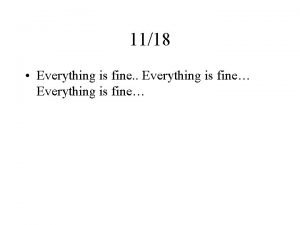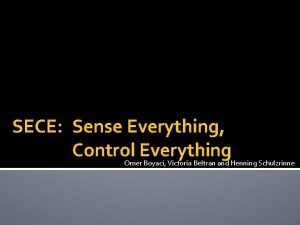SETUP IMPROVEMENT Setup Definition The setup includes everything
















- Slides: 16

SETUP IMPROVEMENT

Setup: Definition • The setup includes everything, all elements and time from the last good piece of the previous job until the first good piece of the next job. • In essence, Setup considers the ACTIVITES and TIME SPAN from GOOD PIECE (A) to GOOD Piece (B)

What setup reduction is not • Not to reduce set-up people – A 50% reduction in setup time will not lead to a 50% reduction in setup people. Typically no reduction in setup people. • Not to produce more product – (except when capacity is a issue)

WHY Reduce Setup times? • Key reason is to Reduce Lot Sizes • Reduced WIP • Reduce Lead Time • Better Quality • Flexibility

Work Content Breakdown Ex. • Preparation, after-process returns, and checking of raw material, blades, dies, jigs, gauges, etc. • Mounting and removing blades, fixtures, chucks, etc. • Centering, dimensioning, & setting of other conditions • Trial run & Adjustments • 30% • 5% • 15% • 50%

Two Kinds of Setup Activity • Internal – Can be performed only when the machine is shut down, or process is not producing. • External – Can be performed while the machine is running, or process is producing.

Fundamental Rule • If an ACTIVITY can be done with the process is running (externally), then it should be done while process is running.

Where to Start • • Bottlenecks Short Lead-time Customer Complaints Delivery

Guidelines & Tips • Review and Document current layout & process – Data Collection • The complexity of the job change will determine how many observations needed • View complete change over whenever possible • Simulate change over when feasible • Video Record • Process Map • Fishbone

Guidelines & Tips • Evaluate process, look for possible enhancements. Incorporate the operator, supervisor, processor, setup person, etc. in the evaluation. • Separate internal and external activities • Reduce internal activities by doing more work externally • Brainstorm for improvements

Guidelines & Tips • Reduce/improve both internal and external activities – Internal • • • Standardize Fixtures Locating Pins Standardize die heights Predetermined X-Y coordinates in CNC machines Standardize & improve clamping methods Reduce the number of bolts

Guidelines & Tips • • • Standardize bolt heads Cut off unnecessary threads U-Washers SPC - Pre-control charts T-slot and U-slots in base plates – External • Eliminate adjustments - potential 40% to 50% • Maintenance of tools, gages & fixtures

Guidelines & Tips • Preset tools and position dies • Assign additional people to setup when feasible • Pre-stage all items - Die carts, tool boards – get tooling, fixtures, dies, and molds • • Dismantle and repair items Clean up Return tooling What paperwork/necessary computer information • Reduce internal activities by doing more work externally

Guidelines & Tips • Coordinate and plan external work – Create a Setup Chart – Color code fixtures and tool – Code location and description of dies – Locate storage as close as possible – Start preparation before the last part is run – Plan for extra manpower

Guidelines & Tips • KEEP AN OPEN MIND, ASK “ WHAT IF” • Test ideas and measure results • Implement improvements • Document the new process

In Conclusion • Quick reaction to the DEMANDS of the market is critical. The ability to give your customers WHAT, WHEN & HOW MUCH they want is essential. Efficiently changing from one job to another job is a MUST.
 Hình ảnh bộ gõ cơ thể búng tay
Hình ảnh bộ gõ cơ thể búng tay Slidetodoc
Slidetodoc Bổ thể
Bổ thể Tỉ lệ cơ thể trẻ em
Tỉ lệ cơ thể trẻ em Chó sói
Chó sói Tư thế worms-breton
Tư thế worms-breton Bài hát chúa yêu trần thế alleluia
Bài hát chúa yêu trần thế alleluia Các môn thể thao bắt đầu bằng tiếng bóng
Các môn thể thao bắt đầu bằng tiếng bóng Thế nào là hệ số cao nhất
Thế nào là hệ số cao nhất Các châu lục và đại dương trên thế giới
Các châu lục và đại dương trên thế giới Công thức tính độ biến thiên đông lượng
Công thức tính độ biến thiên đông lượng Trời xanh đây là của chúng ta thể thơ
Trời xanh đây là của chúng ta thể thơ Mật thư tọa độ 5x5
Mật thư tọa độ 5x5 Làm thế nào để 102-1=99
Làm thế nào để 102-1=99 Phản ứng thế ankan
Phản ứng thế ankan Các châu lục và đại dương trên thế giới
Các châu lục và đại dương trên thế giới Thể thơ truyền thống
Thể thơ truyền thống



















